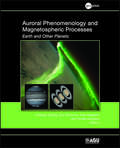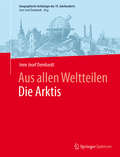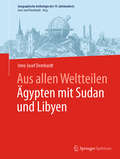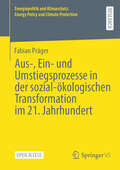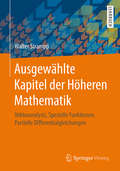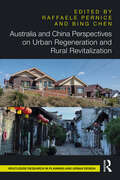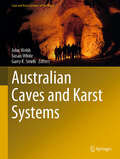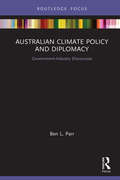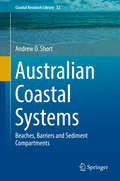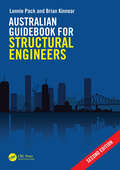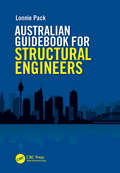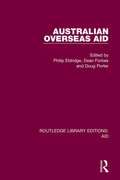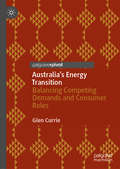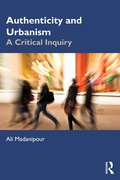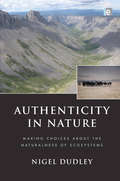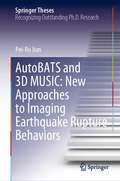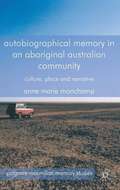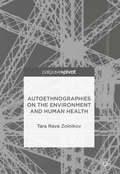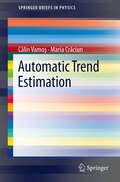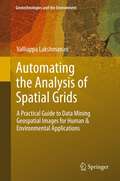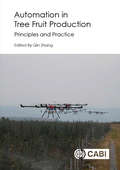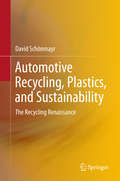- Table View
- List View
Auroral Phenomenology and Magnetospheric Processes: Earth and Other Planets
by Andreas Keiling Tomas Karlsson Eric Donovan Fran BagenalPublished by the American Geophysical Union as part of the Geophysical Monograph Series, Volume 197.Many of the most basic aspects of the aurora remain unexplained. While in the past terrestrial and planetary auroras have been largely treated in separate books, Auroral Phenomenology and Magnetospheric Processes: Earth and Other Planets takes a holistic approach, treating the aurora as a fundamental process and discussing the phenomenology, physics, and relationship with the respective planetary magnetospheres in one volume. While there are some behaviors common in auroras of the different planets, there are also striking differences that test our basic understanding of auroral processes. The objective, upon which this monograph is focused, is to connect our knowledge of auroral morphology to the physical processes in the magnetosphere that power and structure discrete and diffuse auroras. Understanding this connection will result in a more complete explanation of the aurora and also further the goal of being able to interpret the global auroral distributions as a dynamic map of the magnetosphere. The volume synthesizes five major areas: auroral phenomenology, aurora and ionospheric electrodynamics, discrete auroral acceleration, aurora and magnetospheric dynamics, and comparative planetary aurora. Covering the recent advances in observations, simulation, and theory, this book will serve a broad community of scientists, including graduate students, studying auroras at Mars, Earth, Saturn, and Jupiter. Projected beyond our solar system, it may also be of interest for astronomers who are looking for aurora-active exoplanets.
Aus allen Weltteilen Die Arktis (Geographische Anthologie des 19. Jahrhunderts)
by Imre Josef DemhardtGeographische Anthologie des 19. Jahrhunderts Auf den großen Erkundungsfahrten, die im 19. Jahrhundert einen glanzvollen Aufschwung erfahren hatten und maßgeblich an der Etablierung der wissenschaftlichen Disziplin der Geographie beteiligt waren, wurden wissenschaftliche Texte und detaillierte Karten erstellt. Von diesem als ,,geographisches Zeitalter" bezeichneten Jahrhundert gibt es etliche Artikel in geographischen Zeitschriften, die heute zum Teil nur noch schwer aufzufinden oder zugänglich sind. Diesen verborgenen Wissensschatz wieder zu heben, gilt das Interesse der Reihe Geographische Anthologie des 19. Jahrhunderts . Die Autoren bereiten Originaltexte und historisches Kartenmaterial für den modernen Leser durch aktuelle und zeitgemäße Erläuterungen auf und bieten so ein zuweilen vergessenes Panoptikum der Forscherfreudigkeit des 19. Jahrhunderts. Die Arktis, dieses riesige zumeist von Eis bedeckte Gebiet mit dem Nordpol als jahrhundertelangem Sehnsuchtspunkt, war im 19. Jahrhundert das Ziel einer Welle von Expeditionen, die schlussendlich zum Erreichen des Nordpols führten. Die Erkundung der Nordost- wie auch der Nordwestpassage sowie die Entdeckung von Franz-Josef-Land waren weitere bedeutsame Landmarken jener Zeit. Josef Demhardt focussiert sich in diesem Buch auf Auszüge aus dem von Carl Weyprecht in den Mitteilungen der k. k. Geographischen Gesellschaft in Wien verfassten Expeditionsbericht nach Franz-Josef-Land. Die eindrucksvollen Originaltexte, die der Autor kommentiert, nehmen auch den heutigen Leser gefangen und lassen ihn an diesen vergangenen Expeditionen teilhaben.
Aus allen Weltteilen Ägypten mit Sudan und Libyen
by Imre Josef DemhardtGeographen des 19. und frühen 20. Jahrhunderts sammelten auf ihren Reisen faszinierende Erkenntnisse, die sie in deutschsprachigen wissenschaftlichen Zeitschriften (wie Petermanns Geographische Mitteilungen) umfassend erläuterten. Demhardt interpretiert diese Forschungs aus heutiger Sicht, was war neu, was hat sich bewährt, was wurde umgestoßen an Erkenntnissen. Oftmals ist es erstaunlich, welches Wissen damals bereits vorhanden war und heute vielfach in Vergessenheit geraten ist.
Aus-, Ein- und Umstiegsprozesse in der sozial-ökologischen Transformation im 21. Jahrhundert (Energiepolitik und Klimaschutz. Energy Policy and Climate Protection)
by Fabian PrägerDiese Open-Access-Publikation analysiert die Aus-, Ein- und Umstiegsprozesse in der sozial-ökologischen Transformation des 21. Jahrhunderts. Basierend auf den Erkenntnissen der Forschungsarbeiten werden Maßnahmen zur Weiterentwicklung der Energieinfrastrukturentwicklung für eine 100%-Erneuerbare-Energien-Ökonomie erarbeitet. Das Promotionsprojekt beruht auf der Entwicklung und Anwendung eines Forschungsansatzes, der hier als „angewandte Transformationsforschung“ beschrieben wird und sowohl interdisziplinäre als auch transdisziplinäre Wissensproduktion integriert. Der Band untersucht die Notwendigkeit der sozial-ökologischen Transformation, um grundlegende Maßnahmen zu formulieren und ein fundiertes Verständnis für die Entwicklung eines 100%-Erneuerbare-Energiesystems zu schaffen, das den existenziellen Herausforderungen der Klimakrise effektiv begegnet. Zukunftsfähige Maßnahmen und Konzepte für die Energieinfrastrukturplanung werden entwickelt, indem die Theorien der Vordenker*innen der Energiewende analytisch aufgearbeitet sowie aktuelle fossile narrative Barrieren und Verhinderungsstrategien der Energiewende beschrieben und dekonstruiert werden. Die Erkenntnisse werden in tiefgreifende, überwiegend qualitative sozio-technische Sektoranalysen eingebettet.
Ausgewählte Kapitel der Höheren Mathematik: Vektoranalysis, Spezielle Funktionen, Partielle Differentialgleichungen
by Walter StramppAnimationen im Internet veranschaulichen z. B. die Wellengleichung durch eine schwingende Membran, die Wärmeleitung durch eine abnehmende Temperaturverteilung und die Potentialgleichung durch ein von der Randbelegung aufgeprägtes Potenzial. Welche Methoden verbergen sich dahinter, wie erzeugt man diese Animationen? Darauf soll der Leser eine erschöpfende Antwort geben können. Auf ausführliche, formale Beweise wird verzichtet. Die Begriffe werden mittels Beispielen und Graphiken in ihren Grundideen veranschaulicht und motiviert. Der Leser soll Hintergrundwissen und Lösungskompetenz bekommen, damit er sich nicht mit der Formelmanipulation zufrieden geben muss. Studierende sollen in die Lage versetzt werden, Probleme, die sich aus ihrer Bachelor/Masterarbeit oder aus den Anwendungen ergeben, zu bearbeiten.
Austral Ark
by Norman Maclean Adam Stow Norman Maclean Gregory I. Holwell Adam StowAustralia and New Zealand are home to a remarkable and unique assemblage of flora and fauna. Sadly though, by virtue of their long isolation, and a naïve and vulnerable biota, both countries have suffered substantial losses to biodiversity since European contact. Bringing together the contributions of leading conservation biologists, Austral Ark presents the special features and historical context of Austral biota, and explains what is being conserved and why. The threatening processes occurring worldwide are discussed, along with the unique conservation problems faced at regional level. At the same time, the book highlights many examples of conservation success resulting from the innovative solutions that have been developed to safeguard native species and habitats in both New Zealand and Australia. Austral Ark fills an important gap regarding wildlife gains and declines, and how best to take conservation forward to keep this extraordinary area of the world thriving.
Australia and China Perspectives on Urban Regeneration and Rural Revitalization (Routledge Research in Planning and Urban Design)
by Bing Chen Raffaele PerniceThis edited volume reviews important contemporary issues through relevant case studies and research in China and Australia, such as the challenges posed by climate change, the development of eco-urban design, research on sustainable habitats and the relationship between ecology, green architecture and city regeneration, as well as, in general, the future of the city in the new millennium.The authors represent a broad selection of international experts, young scholars and established academics who discuss themes related to urban–rural destruction and economic and spatial regeneration techniques, the sustainable reconversion of natural landscapes and eco-urban design in the context of the current evolution of architectural and urbanism practice. The book aims to explain the conditions in which the contemporary debate about urban regeneration and rural revitalisation has developed in Australia and China, presented by different theoretical and methodological perspectives. It also provides a multifaceted and critical analysis of relevant case studies and urban experiences in Australia and China, focusing on environmental disruption, resized urban interventions and the need for more efficient and sustainable forms of regeneration and urban renewal practice in urban–rural contexts.This book will be an invaluable resource for architects, planners, architectural and urban historians, geographers, and scholars interested in modern Australian and Chinese architecture and urbanism.
Australian Caves and Karst Systems (Cave and Karst Systems of the World)
by Susan White John Webb Garry K. SmithThis book, part of the series Cave and Karst Systems of the World, begins with a review of the interaction between people and caves in Australia (including conservation), followed by descriptions of the spectacular cave diving sites, before comprehensively covering all the major carbonate and noncarbonate karst areas, subdivided by rock type and region, and including the origin of the caves. This is followed by broad overviews of cave minerals and speleothems, cave biology and cave fossils. Each section was written by one or more specialists in the topic and is illustrated by clear diagrams and superb colour photos. The book emphasises the unique aspects of the Australian karst, including the variability in the age of the caves (very old to very young) and the impact of isolation on the stygofauna, as well as the vertebrate fossils preserved in the caves. Written in an easy-to-read style, the book is a primary reference guide to Australian karst and represents a valuable asset for anyone interested in the topic, not only cavers and academics.
Australian Climate Law in Global Context
by Jacqueline Peel Alexander Zahar Jacqueline Peel Lee Godden Alexander ZaharAustralian Climate Law in Global Context is a comprehensive guide to current climate change law in Australia and internationally. It includes discussion of: emission trading schemes and carbon pricing laws, laws on renewable energy, biosequestration, carbon capture and storage and energy efficiency; the trading of emission offsets between developed and developing countries, the new international scheme for the protection of forests (REDD) and the transfer of green finance and technology from developed to developing states, the adaptation to climate change through legal frameworks. It assesses the international climate change regime from a legal perspective, focusing on Australia's unique circumstances and its domestic implementation of climate-related treaties. It considers how the challenge of climate change should be integrated into broader environmental law and management. It is a valuable resource for students in law and environmental science, for current and future legal practitioners and for policy-makers and those in the commercial sector.
Australian Climate Policy and Diplomacy: Government-Industry Discourses (Routledge Focus on Environment and Sustainability)
by Ben L. ParrAustralian Climate Policy and Diplomacy provides a well overdue critique of existing, and high-profile, publications that convey the ‘greenhouse mafia’ hypothesis, which posits that Australia’s weak policy response to climate change is the result of a menacing domestic fossil fuel lobby. Ben L. Parr argues that the shared government–industry discourse about protecting Australia’s industrial competitiveness has had a more decisive influence in shaping and legitimising Australian climate policy than the direct lobbying tactics of the fossil fuel industry. Parr also reveals how the divergent foreign policy discourses and traditions of Australia’s two major political parties – as internationalist versus alliance-focused – have enabled and constrained their climate diplomacy and domestic policies over time. To demonstrate his argument, he presents a discourse analysis woven into a chronological policy narrative, comprising more than 1000 primary texts (media releases, interviews, and speeches) generated by prime ministers and key fossil fuel lobbyists. Overall, this volume illustrates how domestic forces have and are influencing Australia’s climate policy. In doing so, it also provides a framework that can be adapted to examine climate mitigation policies in other countries, notably Canada and the US. This book will be of interest to students and scholars of climate change, environmental policy and governance, and Australian climate change policy and politics more specifically, as well as policymakers and practitioners working in these fields.
Australian Coastal Systems: Beaches, Barriers and Sediment Compartments (Coastal Research Library #32)
by Andrew D. ShortThis book describes the entire coast and beaches and barrier systems of Australia. It covers the coastal processes and systems that form and impact Australia's 30.000 km coast, 12.000 beaches and 2750 barrier systems. These processes include geology, geomorphology, climate, waves, tides, currents, sediment supply, as well as coastal ecosystems. The coast is divided into tropical northern and southern temperate provinces, within which are seven divisions, 23 regions and 354 coastal sediment compartments each of which is described in detail in the 34 chapters. Within these systems are the full range of wave through tide-dominated beaches and barriers ranging from cheniers to massive transgressive dune systems together with a range of onshore and longshore sand transport systems. This is an up to date reference for the entire coast, its present condition and likely responses to the impacts of climate change.
Australian Guidebook for Structural Engineers
by Lonnie Pack Brian KinnearThis guidebook is a practical and essential tool covering all the necessary steps for structural design engineers to create detailed and accurate calculations in accordance with Australian and international standards.General project requirements are explained in terms of project management and document control. Calculation methods and details are shown for actions (wind, seismic, dead and live loads). Design details are then provided for steel, concrete, timber, and geotechnical calculations (footings, piles, retaining walls, etc.). Detailed worked example calculations are included throughout the text, as well as typical CAD details for design drawings. Design items are explained for typical items of equipment found across various industries (e.g. piping, vessels, lifting, machine foundations, access, composite structures, bunds, and more). Design aids are provided, including guides and examples for popular engineering programs (Space Gass, Strand7 and Rhinoceros 3D). Comprehensive capacity tables are also included for steel and concrete elements.This edition has been updated to include the latest design requirements from Australian Standards, including Steel Structures (AS 4100–2020), Concrete Structures (AS 3600–2018) (including steel fibre reinforced concrete slabs), Earthquake Actions (AS 1170.4–2024), and basic requirements from Timber Structures (AS 1720.1–2010). Requirements from many more Australian Standards and international standards are also provided in the context of typical design projects.
Australian Guidebook for Structural Engineers
by Lonnie PackThis guidebook is a practical and essential tool providing everything necessary for structural design engineers to create detailed and accurate calculations. Basic information is provided for steel, concrete and geotechnical design in accordance with Australian and international standards. Detailed design items are also provided, especially relevant to the mining and oil and gas industries. Examples include pipe supports, lifting analysis and dynamic machine foundation design. Steel theory is presented with information on fabrication, transportation and costing, along with member, connection, and anchor design. Concrete design includes information on construction costs, as well as detailed calculations ranging from a simple beam design to the manual production of circular column interaction diagrams. For geotechnics, simple guidance is given on the manual production and code compliance of calculations for items such as pad footings, piles, retaining walls, and slabs. Each chapter also includes recommended drafting details to aid in the creation of design drawings. More generally, highly useful aids for design engineers include section calculations and force diagrams. Capacity tables cover real-world items such as various slab thicknesses with a range of reinforcing options, commonly used steel sections, and lifting lug capacities. Calculations are given for wind, seismic, vehicular, piping, and other loads. User guides are included for Space Gass and Strand7, including a non-linear analysis example for lifting lug design. Users are also directed to popular vendor catalogues to acquire commonly used items, such as steel sections, handrails, grating, grouts and lifting devices. This guidebook supports practicing engineers in the development of detailed designs and refinement of their engineering skill and knowledge.
Australian Overseas Aid
by Doug Porter Dean Forbes Philip EldridgeOriginally published in 1986, this book evaluated the review of the Australian Overseas Aid Program (the 1984 Jackson Report) and discusses the significance of Australia’s contribution to overseas aid for the future. The book focusses on the overall context of the Jackson report; discusses the geographical distribution of aid proposed by the report and examines aid administration in its more specific bureaucratic context and with broader questions of community participation in developmental processes.
Australian Precious Opal
by Archie KalokerinosThe magnificent splendour of the Australian opal that has fascinated the world for almost a century is still clad in a mysterious veil of fear and superstition whose only explanation is the lack of knowledge. This book attempts to clear the cloud to some extent to the enjoyment of the readers.
Australia’s Energy Transition: Balancing Competing Demands and Consumer Roles
by Glen CurrieThis book studies Australia, a country characterized by the highest concentration of domestic photovoltaic systems. In addition, the high level of solar energy that Australia receives makes these systems a significant part of its energy mix. International electricity system managers take note; your systems are heading this way. The energy transition is an emerging field, and few texts have been published that can help energy planners as this book does. The research presented is sociotechnical in nature, and reveals that the main challenge in the energy transition is its emerging social role. Very few works combine the social and technical fields of energy. Given its scope, the book will appeal to readers interested in policy, regulation, and energy systems, including government employees involved in energy system management all around the world.
Authenticity and Urbanism: A Critical Inquiry
by Ali MadanipourThis book investigates authenticity, an important but controversial cultural concept, and its relevance for urban socio-spatial processes. Defining authenticity as an evaluative relationship with an origin, it unpacks a range of origins from a critical, non-essentialist perspective: self, author, substance, event, time, place and society.Authenticity is a key concept in contemporary culture. It was selected as the word of the year 2023 by Merriam-Webster, it is significant for UNESCO in designating the world heritage, a philosophical battleground, and reflecting concerns about truth and trust in the digital age. This book offers a clear understanding of the concept and discusses its implications for urbanism, understood as both material and relational, both physical and social. It critically examines whether authentic urbanism may be possible through seeking a solid ground in the self, in the act of making, in the substance of objects, in transformative events, in particular times and places, and in society and culture.Analysing the complexities, nuances, and controversies of the concept of authenticity, and their implications for urban space and society, this book explores the promises and pitfalls of authenticity, looking for ways of avoiding its dangers and searching for its creative potential. Students and scholars in urban studies, geography, urban design, planning, and architecture, as well as in sociology and cultural studies, would find this interface between ideas and practices informative and insightful.
Authenticity in Nature: Making Choices about the Naturalness of Ecosystems
by Nigel DudleyThis book examines the concept of naturalness in ecosystems, discusses its values and considers choices about the level of naturalness in conservation efforts. The author argues that all ecosystems have been modified and the idea of places 'untouched by humans' is a myth. But there are large differences in the degree of modification and levels of naturalness which can be identified. Changes are not always irreversible; some apparent wilderness areas are sites of former civilizations. There is no longer any simple distinction possible between 'natural' and 'cultural' systems. In the future, society will, to some extent, choose the degree of naturalness in land and seascapes. The growth of protected areas is an early sign of this, as are changes in forest management, dam removal and control of invasive species. To make informed choices about these areas, the author shows that we must understand the characteristics and values of naturally regulating ecosystems – their practical benefits, social values and management needs. Authenticity in Nature uses a rigorous definition of authenticity to help in the understanding and measurement of naturalness. It discusses the choices facing us and some of the information we need to make decisions relating to land and water management. Practical issues of management and numerous terrestrial and aquatic examples from around the world are discussed. It is an optimistic and highly original book, aiming to make genuine advances in our understanding and management of natural systems.
AutoBATS and 3D MUSIC: New Approaches to Imaging Earthquake Rupture Behaviors (Springer Theses)
by Pei-Ru JianThis book presents the kinematic earthquake rupture studies from moment tenor to spatial-temporal rupture imaging. For real-time seismic hazard monitoring, the new stable automatic moment tensor (AutoBATS) algorithm is developed and implemented for the real-time MT reports by the Taiwan Earthquake Science Information System (TESIS). In order to understand the rupture behavior of the 2013 Mw 8.3 Okhotsk deep earthquake sequence, the 3D MUltiple SIgnal Classification Back Projection (MUSIC BP) with P and pP phases is applied. The combined P- and pP-wave BP imaging of the mainshock shows two stages of anti-parallel ruptures along two depths separating for about 10~15 km. Unusual super-shear ruptures are observed through the 3D BP images of two Mw 6.7 aftershocks. In last two chapters, the 3D BP imaging reveals similar rupture properties of two shallow catastrophic earthquakes (Mw=6.4) in southwestern Taiwan. Both the 2010 Jiashian and 2016 Meinong earthquakes ruptured westward with similar velocity of ~2.5 km/s along a NE-ward shallow dipping blind fault. The rupture similarities of the doublet suggest two parallel elongate asperities along the causative fault. After several decades of seismic quiescence, the 2010 Jiashian event initiated the rupture at the deeper asperity and triggered the shallower asperity which caused catastrophes six years later.
Autobiographical Memory in an Aboriginal Australian Community
by Anne Marie MonchampThis book shares and analyses the stories of Opal, a senior Alyawarra woman. Through her stories the reader glimpses the harsh colonial realities which many Aboriginal Australians have faced, highlighting the cultural embeddedness of autobiographical memory from a philosophical, psychological and anthropological perspective.
Autoethnographies on the Environment and Human Health
by Tara Rava ZolnikovThis book explores the link between individual lives and significant environmental issues affecting millions of people around the world. Zolnikov offers a novel perspective on the environment and human health through autoethnographic stories. Each chapter includes an overview of an environmental risk factor or issue, such as air quality, accompanied by a reflective personal story. Her experiences were gathered around the world and revolve around immersion into local cultures. Learning about environmental health through this qualitative approach will enable readers to understand how issues in the environment are currently affecting people on an individual basis.
Automatic trend estimation (SpringerBriefs in Physics)
by Maria Cr˘aciun C˘alin Vamos¸Our book introduces a method to evaluate the accuracy of trend estimation algorithms under conditions similar to those encountered in real time series processing. This method is based on Monte Carlo experiments with artificial time series numerically generated by an original algorithm. The second part of the book contains several automatic algorithms for trend estimation and time series partitioning. The source codes of the computer programs implementing these original automatic algorithms are given in the appendix and will be freely available on the web. The book contains clear statement of the conditions and the approximations under which the algorithms work, as well as the proper interpretation of their results. We illustrate the functioning of the analyzed algorithms by processing time series from astrophysics, finance, biophysics, and paleoclimatology. The numerical experiment method extensively used in our book is already in common use in computational and statistical physics.
Automating the Analysis of Spatial Grids: A Practical Guide to Data Mining Geospatial Images for Human & Environmental Applications (Geotechnologies and the Environment #6)
by Valliappa LakshmananThe ability to create automated algorithms to process gridded spatial data is increasingly important as remotely sensed datasets increase in volume and frequency. Whether in business, social science, ecology, meteorology or urban planning, the ability to create automated applications to analyze and detect patterns in geospatial data is increasingly important. This book provides students with a foundation in topics of digital image processing and data mining as applied to geospatial datasets. The aim is for readers to be able to devise and implement automated techniques to extract information from spatial grids such as radar, satellite or high-resolution survey imagery.
Automation in Tree Fruit Production: Principles and Practice
by Qin ZhangThe technology that allows automation in agriculture is rapidly developing and being applied to wide variety of key crops. This book focuses on automation in tree fruit crops worldwide. It covers topics such as automated tree fruit production systems, plant stress sensing and high-throughput phenotyping in precision horticulture, the economics of automation in tree fruit production, light interception sensing systems for canopy management, precision irrigation and water management, precision technologies for pest and disease management, opportunities for the application of robotics in tree fruit production, and the mechanical harvesting and handling of fruit crops.
Automotive Recycling, Plastics, and Sustainability
by David SchönmayrThis book provides transdisciplinary analyses of the automotive plastics production and recycling system, including prognoses, scenarios and solutions for corporate sustainability management.A book on plastics, not written by a plastics guy. But a sustainability guy. Plastics schizophrenia and the automotive abyss: The industry is facing a severe challenge. It is the inevitable and promising change towards a sustainable economy. However, the automotive industry is primarily concerned with the CO2 emissions from cars when driving, while the rise of lightweight plastics, electric drive and heavy batteries make the production and end-of-life phase ever more important. Therefore, the currently increasing use of non-sustainable virgin plastics in cars has to be tackled.The plastics and the automotive industry now have a chance, and this chance is the Recycling Renaissance.This book offers:• Holistic and transdisciplinary overview on sustainability and automotive plastics from all angles including economy, ecology, technology, and politics with a focus on Europe• Concise analyses, prognoses, tools and a roadmap with solutions for companies, developed together with international experts from industry and academia • Strong scientific basis and independent research including a Europe-wide survey, expert interviews, and workshops• More than 80 illustrations and 15 tables including a SCOT analysis • Executive summaries after each chapter for fast reading“The uniqueness of this book lies within the different point of view on this topic from a critical, outstanding scientist.” - Univ.-Prof. Dipl.-Ing. Dr.mont. Pomberger, Montanuni Leoben
